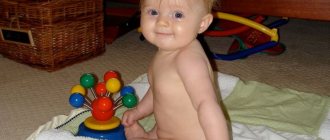When does a baby start crawling?
Having started to crawl, the child seems to change dramatically: only recently he was lying in a crib and simply jerking his arms and legs, but now he cannot be restrained. It often happens that at one month the baby begins to crawl, sit up and stand on his own legs. This happens most often around six months. By 4-5 months, the baby already knows how to roll over, holds her head well in a lying position on her tummy and, with her arms outstretched, gradually begins to lift her butt, swaying from side to side. His motor development is gaining momentum.
At first, the little one moves hesitantly, with barely noticeable movements - such that it may even seem like you imagined it. He tries very hard, and after he succeeds once, he will begin to do it more and more often and more decisively. If the child is not one of those who immediately moves from a sitting/lying position to a standing position, then he masters crawling in the range of 5 to 9 months.
Why is crawling useful?
Crawling is a very important stage in the development of a child up to one year old, because such movements are not only joy for parents, but also a huge contribution to his health. In the process of crawling, especially if the baby does it not like a frog, but with all four limbs, all the muscles that strengthen the spine are involved. And the role of the spine in the human body can hardly be overestimated: it is its foundation to which all other organs are attached.
By crawling and moving, the child strengthens it and prepares it for imminent loading - a vertical position. In addition to the enormous benefits for the musculoskeletal system, psychologists also note considerable importance in brain development. So moving on all fours activates the work of both hemispheres: left and right. While crawling, the vestibular apparatus is trained, fine motor skills and visual perception are developed.
Massage
Massage sometimes plays a key role in learning to crawl, helps stimulate the muscular and musculoskeletal system, and tones.
There are some rules for massage:
- Ventilate the room before starting the session. The temperature in the room should not be very low, but freshness and coolness are the best companions for massage.
- Be sure to wait at least 60 minutes after your child's last meal.
- Do not start massage if your baby is sleepy or capricious.
- Do not overdo it with massage products: your hands can only be slightly moistened with massage oil or Vaseline.
- Do not make sudden or rough movements.
- Be sure to wash your hands before starting the massage with warm water so that the child does not feel cold from touching.
The massage procedure itself should be aimed at normalizing blood flow. The child should be placed on a soft surface (plaid or blanket). The first movements should be soft, neat, smooth, and the process itself should not exceed 7-10 minutes at first. Over time, the duration of the massage can be increased by 1-2 minutes.
- Massaging movements are first made on the back in the direction from the shoulders to the sides, each time the massage therapist’s hands should fall lower. On the lower back, the movements change to stroking: smooth, even movements are made with the palms from the waist to the armpits.
- Stroking should alternate with kneading movements. Each manipulation is carried out 10-30 times with an equal interval between actions.
- You definitely need to walk along your back with the edges of your palms, without pressing or making much effort.
- Then the little one rolls over onto his back, and the masseur begins to gently knead his feet and toes, moving towards the groin area.
- Hands are massaged in the same way - from palms to shoulders.
Why doesn't the baby crawl?
A child up to one year old grows and develops as if repeating the entire evolution of humanity: emerging from a small cell, he becomes a fetus, is born, first gets on all fours, and then on his feet. However, not all children follow this path. It often happens that, being absolutely normal and healthy, they bypass the crawling phase and immediately begin to walk. And there is no point in being upset about this, since no one can radically influence this.
The physiological development of a baby is purely individual and is not determined by hereditary factors (unlike eye color, body structure, etc.). Don’t let this upset you for the reason that if a child independently (!) without the encouragement of an adult stood up on his feet early or walked, skipping the crawling stage, then this indicates that he is completely ready for this.
Reasons why a child may not want or be able to crawl may include:
- Overweight. Thin children are more active and mobile, but “chubby” children are hampered by weight, since their bones are still weak and it is difficult for them to bear it
- Underdevelopment of muscles, for example, due to rickets. Vitamin D deficiency disease directly affects bones
- Injuries
- Long-term abuse of walkers. Using a walker for more than an hour while knocking slows down the development of crawling skills
- Prolonged immobilization of limbs. For example, applying plaster or rings for hip dysplasia
- Child's temperament
- Weak muscles. A good workout will be provided by a general therapeutic massage and regular placement of the baby on the tummy.
Important: you should not try to determine the cause yourself. The diagnosis is the doctor’s business!
How to determine the size of a child’s shoes, read our article?
Where to go with a child in St. Petersburg, read here.
What to do if a newborn has constipation, you can find out here
Where to crawl? Why crawl?
Many children do not strive to learn to crawl: they either lie down and play with toys, or call their mother demandingly if they want to move, or do not have any interest in objects that they cannot reach without difficulty. Most neurologists believe that this is not very good, since a child’s crawling is an important and necessary moment in the physical and psychological development of the baby.
Why do you need to crawl and what is crawling from the point of view of the baby’s psychological development? This is, first of all, the desire and opportunity to obtain what is inaccessible, but desired. A baby's vision at the age of 6-7 months is already well developed enough to see a toy that is far beyond arm's length. Understanding that a subject is inaccessible without effort, making efforts, overcoming difficulties, a long-awaited victory are important for shaping the character of the baby. Roughly speaking: if something does not come on its own, it can be achieved if you work hard. This is a kind of matrix of success, training in hard work.
From a physical development perspective, crawling is even more important. Trying to move on all fours, the baby learns to control its body and develops the most important nervous reactions. In order to crawl, you need to form:
And it's not that simple.
Review. The baby gradually learns to recognize sound and visual signals and respond to them. Now he has already learned to follow the toy that his mother moves, to turn his head to the sound of her voice. He learned to understand that he needs to roll over if the toy is lying to his left or right. And now he needs to learn to correlate his body, its size and capabilities with the information that he receives with the help of his eyes. Which direction to move, how to move, how to avoid obstacles. Don’t forget that when lifting the body onto all fours, the baby’s picture of the world literally “changes” - and this is also a new and complex sensation.
When crawling, different fields of vision are activated. It is especially important that the baby learns to look down - “under the arms.” Neurologists believe that good development of the lower visual field prevents many problems in the future: it helps to successfully master school skills, and just be careful, “watch your step.” The “height” coordinate is formed, which the crawling baby masters more systematically and confidently than the one whom caring parents began to put on his feet, supporting him under the arms, bypassing the crawling stage.
Turn. In order for crawling to take place, the child must go through the previous stages of ontogenetic development in the “correct” order:
- learn to hold your head while lying on your stomach;
- lying on your stomach, lean on your open palms, forearms, and then outstretched arms;
- roll over on your side, from your back to your stomach and from your stomach to your back.
All these skills prepare the muscles for the upcoming load, and the brain, in the process of mastering them, processes huge volumes of signals from the body and analyzes visual information.
Alternation. Coordinating the movement of four limbs is not a joke, but a complex work of the brain. By the way, scientists racked their brains for a long time before making a dog-like robot that could move on four legs; a lot of microcircuits were soldered a hundred times. It’s the same with a child who doesn’t succeed in everything right away. But when he succeeds in the movements, it brings joy not only to him, but also to the neurologist. Very, very often, it is in the process of crawling that children are compensated and cured of those neurological problems that were not completely resolved with the help of massage: torticollis, uneven tone of the muscles of the arms and legs.
And vice versa - asymmetrical, specific crawling with dragging or tucking one leg or arms, which persists for more than 2-3 weeks, may be a symptom of features of brain development that cannot be identified by any research, but which, nevertheless, can complicate future life - for example, schooling. Thanks to the baby’s persistence or exercise, crawling will be regulated and connections between parts of the brain will return to normal.
How to teach a child to crawl?
As noted earlier, if your child has firmly decided not to crawl, then it is unlikely to radically change this state of affairs, but you can help those who are still trying.
Method 1. Show. Now your baby is swaying from side to side on all fours and a little more and he will crawl. But, despite the fact that he needs very little to move, this can drag on for a long period.
If a child rocks on all fours and tries to crawl for more than a month, then you need to tell the pediatrician about this.
So you can
- get down on all fours next to the child and demonstrate all the simple science by your own example
- supporting the belly, lift the baby a little and move his arms and legs simultaneously (it’s better to show together: one holds, the other moves)
Method 2. Motivate.
Place the toys in front of the baby so that they interest him, but he cannot reach them. You shouldn’t display variety: the child’s attention may wander; one or two objects will be enough. Even if he doesn't succeed after a few minutes and gives up trying, you can move your baby slightly to reward him for his work.
Sit opposite the baby and call him: by name or affectionate nickname and beckoning with your hands.
Method 3. Exercise.
From 4 months, when doing gymnastics for your child, add the following exercises:
- For a baby lying on his tummy, place your palms under his feet as a support so that he can push off from them
- Also, in a position on your tummy, alternately bend and unbend each leg, pull it towards your stomach or side
Method 4. Special devices.
There are quite inexpensive crawling tracks for children on sale. They are a flat, narrow surface with sides on the sides. They install it at a slight slope in the form of a low slide and place the baby, who will quietly slide down. Gradually, the chaotic movements of the arms and legs will begin to be ordered, and the baby will learn to control them. A mattress and changing board can also be used for this purpose.
All these actions should be embodied in a playful mood, as they are also a fun way to spend time together. In order to facilitate attempts at encroachment, it would be good to prepare the conditions for this. It is easiest to learn to crawl on a floor, preferably a smooth one. There should be no objects nearby that could interfere with the baby’s movements. It goes without saying that the surface must be clean and safe (there should be no small, sharp objects, any parts, or household appliances on it). The child should wear comfortable clothing that fits properly and that will not restrict movement or get tangled.
Methods and stages of crawling in boys and girls
There are several stages of crawling that the baby masters one by one, but he does not necessarily go through them all.
Stomach crawling
The earliest stage is crawling on your stomach. This skill manifests itself from 4-5 months. First, the child learns to lift the body with outstretched arms. To reach this or that object, he tries to move - most often backwards or sideways. To stimulate such activity, parents should place toys or bright things in the baby’s field of vision that he will try to grab.
In Plastun style
The skill of plastun movement is mastered by the baby at the age of about 8 months. To do this, he lifts his torso, leans on his hands and tries to tighten his body.
Many children skip this stage and immediately get on all fours.
On knees
The baby rests his hands on the support, kneels and raises his torso. At first he doesn't understand what to do. Therefore, he simply stands on all fours, rocking back and forth or from side to side. Next, he tries to put his hands forward one after the other, pulling his body towards them (reminiscent of a frog jump).
By 9 months, the child is able to move his arms and legs quickly and confidently.
Cross crawl
The most difficult is the cross crawl. This skill is considered the pinnacle of mastery. It is characterized by synchronization of movements - at the same time as the right hand, the left leg extends, then the movements change clearly and harmoniously. The baby learns such coherence and harmony gradually, constantly improving his skills.
The child crawls backwards: what to do?
Many children begin to crawl backwards. They stretch out their arms, push off from them and seem to slide backwards. Use the same manipulations as when mastering crawling: stimulate with toys, call to you. Over time, the child will learn to coordinate its movements and crawl forward, although some still use this original method.
The development of newborns week by week, we read in our article.
You can learn how to treat diarrhea in a child from our article.
How to choose an inhaler for a child, read the link
Why does a child crawl on his back? How can I help my child learn to crawl correctly?
Children, in their quest to understand the world and master their possessions, sometimes surprise adults. So, they even manage to make their methods of movement very funny: they crawl like worms, backwards, sideways, on their bellies (without lifting their bellies), and jump like a frog. All these methods are not some kind of deviations from the norms, and there cannot be any norms in this matter: kids try different methods and repeat what they do by chance. On his back, the child rather does not crawl, but glides, pushing off with his legs and lifting his butt. This method is usually only temporary, until the baby learns something new. To teach him to crawl differently, place the baby on his tummy more often.
Proper organization
When teaching a child motor skills, there are several important aspects to consider.
- There should be nothing dangerous on the baby’s path that could hurt him or that he could put in his mouth. Young researchers at this age try out everything that comes their way and gets their hands on it.
- It is better to conduct training on the floor so that the baby does not accidentally fall and hurt himself. In addition, if a toddler falls, he may get scared.
- The floor should be warm and non-slip. Carpets or blankets should not slide on it.
- Before starting class, it is important to make sure that there is no small debris or dust on the carpet. Therefore, it is better to vacuum the coating first.
- The child needs constant parental supervision. They hold him and secure him.
- It is important that nothing interferes with the baby or restricts his movements: tight clothes, folds of the blanket, uncomfortable diapers. It is better to leave him with a minimum of clothing.
- The temperature in the room should be comfortable.
- You cannot start classes immediately after waking up, or when the child is sick, has a fever, is teething, is naughty, or has just eaten a heavy meal.
- Parents need to remember that incentives are important for the future slider. These could be his favorite toys (especially those that play tunes), fruits, or anything else that will interest the baby. But the most important incentive is the calls and praise of parents, encouragement, affection.
Dr. Komarovsky: how to teach a child to crawl?
Evgeniy Olegovich Komarovsky tirelessly repeats the benefits of crawling as opposed to early disembarkation or staying in special devices that put the child in an upright position (for example, walkers). However, he calls all accepted standards regarding when a child should sit, crawl or stand on his feet as deeply exemplary. Thanks to this doctor, young mothers, having listened to all-knowing people around them, realized that the child does not owe anything to anyone.
When the time comes, he will crawl, when his muscles become stronger, he will sit down, when he is ready, he will stand up. Komarovsky's statements are always based on common sense. He notes that a distinctive feature of a person is upright posture, which, however, brings with it diseases such as radiculitis and scoliosis. Therefore, early premature load on the spine leads to the fact that it does not have time to fully strengthen.
The later the child gets on his feet and walks, the stronger the spine will be; the more actively the child crawls, the stronger the back muscles will be.
The child will learn to crawl - with or without your help, the main thing is to encourage him in this matter and remember: the more, the better.
Crawling is a very desirable phase in a child's development. Each baby begins to crawl at a different time and in different ways. And some people don’t crawl at all or suddenly start crawling after they’ve started walking. In any case, do not limit the child to the crib or playpen area, give him the opportunity to actively grow. It is very important not just to teach a child to crawl, but to systematically devote a lot of time to this movement.
Conditions for skill development
If parents want to teach their baby to crawl, then they can help him by creating suitable conditions for the development of this skill.
- First of all, the child will need room to move.
The best solution for this is flooring. In a playpen or other confined space, the baby has no incentive to crawl. Therefore, you need to lower the baby to the floor, having previously prepared him and removed dangerous objects away.
- The surface for learning must be hard and tough.
This could be a special rug, a hard blanket, etc. You should not put your baby on slippery parquet or linoleum. The bed is also unlikely to be suitable - it is too high. You should also not use inclined planes.
- It is necessary to lure the baby and stimulate his physical activity.
The “bait” can be a favorite toy, a new interesting object, a domestic cat or dog. In general, it is good to surround your child with interesting things to attract his attention.
- You can place small obstacles in the form of a twisted blanket and other things along the path of the crumbs.
This will force the baby to raise his body if he crawls on his belly.
- Another way to teach a little explorer is to place him in an environment of the same crawling children.
This could be an early development center or just invite friends with kids to visit. And perhaps soon you will be able to take part in such a championship:











